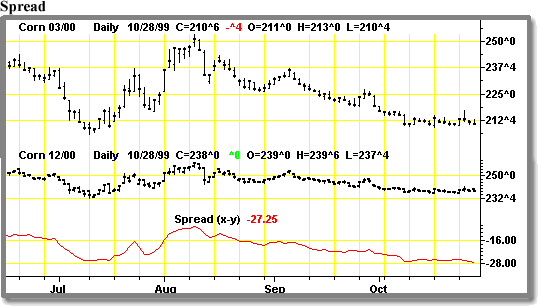|
Commodity spreads ( or straddles) measure the price difference between two different contracts, usually futures contracts. The price difference is often analyzed in special futures spread charts. Spreads can also measure the difference between a cash contract and a futures contract ( referred to as the basis) or the price difference between two option contracts, or various combinations of the above. For the purpose of this section you will examine spreads from the context of the price difference between two different futures contracts.(see figure 6)
In the grain business the difference between two contract months of the same commodity ( ie., canola) represents the carrying charges or the cost of holding the commodity for a period of time. Carrying charges are determined by the cost of interest and storage when physical commodities are held in store. Grain traders will monitor spread relationships very closely as the relative difference between various contract positions will determine the handling margins or profitability of their involvement in marketing grain. When using spreads, the trader hopes to profit by changes in the spread (difference) between the two contracts . The trader is looking for either a widening or narrowing of the spread relationship over time. Spread trading is considered to be a less risky and often less expensive way in which to participate in the futures market. Margin requirements for spreads are generally lower than outright long or short positions, and whether the price increases or decreases the traders risk is limited to the change in the spread, since both a long and a short position are held at the same time. Since the risk is lower, so will be the potential for profit or loss. Spread trading is more complicated than outright trading and requires a higher degree of sophistication on the part of the trader. You will examine only briefly the application of spread trading to farm marketing management in this course. The purpose of this section is to familiarize yourself with the use of commodity spreads in forecasting market direction. By monitoring the relative strength between various contracts and between different markets, you will be better able to select the appropriate pricing and risk management strategies when developing your marketing plan.
Note that TradingCharts offers premium, customizable spread charts. Click here for more information.
Besides being used for spread trading, tracking the spread relationships between different contracts in the same market or in different markets can provide useful insights into future price direction. The relationships between the nearby and the distant months in the same commodity often tell us about the relative strength or weakness of the market itself. For example; the June 1993 Canola contract traded at a substantial premium to the November, 1993 contract up until May 1993. A perceived shortage of top quality canola following the frost of August 1992 resulted in 1992 canola values gaining on the 1993 contract positions. This relationship continued until it became apparent later in the marketing year that an adequate supply of canola was available to satisfy buyer's needs in addition to farmers' requirements for cash flow prior to seeding a new crop. The spread relationship between the two different marketing years then reversed direction, as buyers and sellers focused their attention on the upcoming 1993/94 canola production prospects.

In situations such as this, caused by perceived tightness of stocks, the nearby months will usually rise faster than the distant months. This is referred to as a bull spread. In order to profit from this relationship you would buy the nearby futures contract and simultaneously sell the more distant contract. Conversely in situations where the near term supplies are in relative over abundance in relation to future supplies, the nearby months will usually fall faster than the distant months. A bearish approach to the market would be undertaken by entering a bear spread.
In order to profit from this relationship you would sell the nearby contract month and buy the distant contract month. By monitoring the relationship between the nearby and the distant months, you often will be provided with a lead indication as to whether the market will trend higher or lower.
[ PREVIOUS: Chart Patterns ] -- [ CONTENTS ] --
[ NEXT: Technical Indicators ]
|